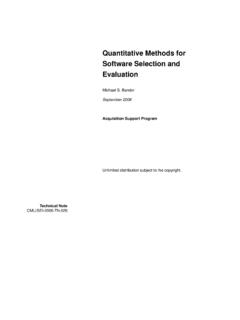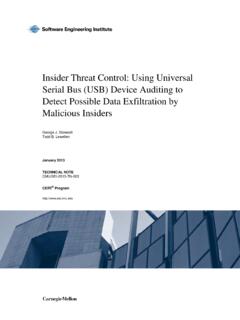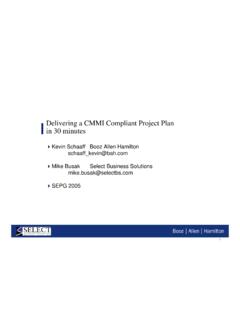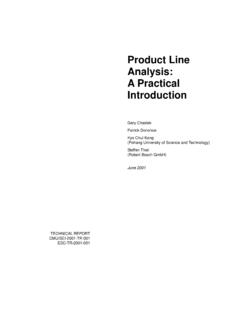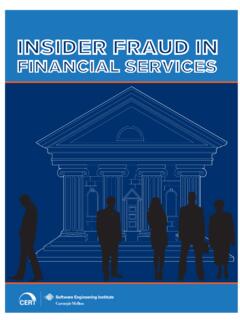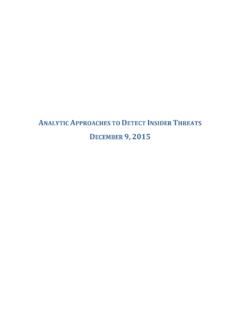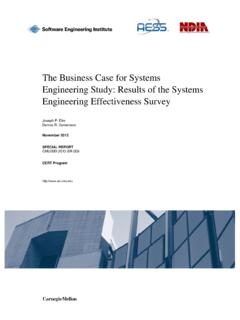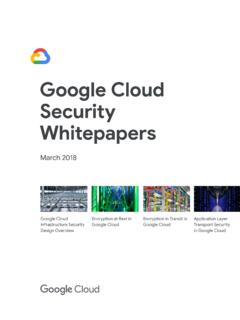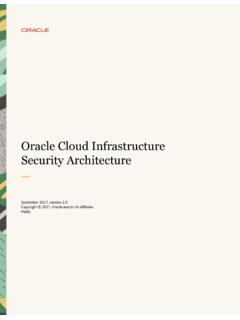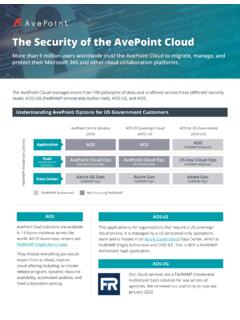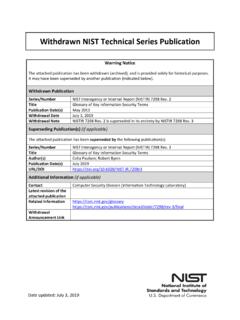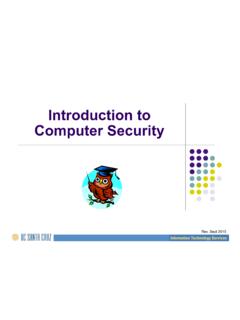Transcription of Structuring the Chief Information Security Officer Organization
1 Structuring the Chief Information Security Officer Organization Julia H. Allen Gregory Crabb (United States Postal Service) Pamela D. Curtis Brendan Fitzpatrick Nader Mehravari David Tobar September 2015 TECHNICAL NOTE CMU/SEI-2015-TN-007 CERT Division Copyright 2015 Carnegie Mellon University This material is based upon work funded and supported by USPS under Contract No. FA8721-05-C-0003 with Carnegie Mellon University for the operation of the Software Engineering Institute, a federally funded research and development center sponsored by the United States Department of Defense. Any opinions, findings and conclusions or recommendations expressed in this material are those of the author(s) and do not necessarily reflect the views of USPS or the United States Department of Defense.
2 This report was prepared for the SEI Administrative Agent AFLCMC/PZM 20 Schilling Circle, Bldg. 1305, 3rd floor Hanscom AFB, MA 01731-2125 NO WARRANTY. THIS CARNEGIE MELLON UNIVERSITY AND SOFTWARE ENGINEERING INSTITUTE MATERIAL IS FURNISHED ON AN AS-IS BASIS. CARNEGIE MELLON UNIVERSITY MAKES NO WARRANTIES OF ANY KIND, EITHER EXPRESSED OR IMPLIED, AS TO ANY MATTER INCLUDING, BUT NOT LIMITED TO, WARRANTY OF FITNESS FOR PURPOSE OR MERCHANTABILITY, EXCLUSIVITY, OR RESULTS OBTAINED FROM USE OF THE MATERIAL. CARNEGIE MELLON UNIVERSITY DOES NOT MAKE ANY WARRANTY OF ANY KIND WITH RESPECT TO FREEDOM FROM PATENT, TRADEMARK, OR COPYRIGHT INFRINGEMENT. This material has been approved for public release and unlimited distribution except as restricted below. Internal use:* Permission to reproduce this material and to prepare derivative works from this material for internal use is granted, provided the copyright and No Warranty statements are included with all reproductions and derivative works.
3 External use:* This material may be reproduced in its entirety, without modification, and freely distributed in written or electronic form without requesting formal permission. Permission is required for any other external and/or commercial use. Requests for permission should be directed to the Software Engineering Institute at * These restrictions do not apply to government entities. Carnegie Mellon and CERT are registered marks of Carnegie Mellon University. DM-0002696 CMU/SEI-2015-TN-007 | SOFTWARE ENGINEERING INSTITUTE | CARNEGIE MELLON UNIVERSITY i Table of Contents Acknowledgments vii Abstract ix 1 Introduction 1 2 Define Subfunctions, Activities, and Departments 3 Process 3 Departments, Subfunctions, and Activities 7 3 Derive and Describe the CISO Organizational Structure 11 Derive 11 Describe 11 Program Management 11 Security Operations center 12 Emergency Operations and Incident Command 13 Security Engineering and Asset Security 13 Information Security Executive Council 15 4 Sizing the CISO Organization 16 5 Recommended Next Steps 18 Appendix A: Mappings of Functions, Departments, Subfunctions, and Activities 19 Appendix B.
4 Complete List of Source Acronyms 29 Bibliography 33 CMU/SEI-2015-TN-007 | SOFTWARE ENGINEERING INSTITUTE | CARNEGIE MELLON UNIVERSITY ii CMU/SEI-2015-TN-007 | SOFTWARE ENGINEERING INSTITUTE | CARNEGIE MELLON UNIVERSITY iii List of Figures Figure 1: Four CISO Functions 2 Figure 2: Process for Deriving a CISO Organizational Structure 4 Figure 3: CISO Organizational Structure 11 CMU/SEI-2015-TN-007 | SOFTWARE ENGINEERING INSTITUTE | CARNEGIE MELLON UNIVERSITY iv CMU/SEI-2015-TN-007 | SOFTWARE ENGINEERING INSTITUTE | CARNEGIE MELLON UNIVERSITY v List of Tables Table 1: Sample CISO Function to Source Mapping 5 Table 2: Source Acronyms 6 Table 3: Protect, Shield, Defend, and Prevent Departments, Subfunctions, and Activities 7 Table 4: Monitor, Hunt, and Detect Departments, Subfunctions, and Activities 8 Table 5: Respond, Recover, and Sustain Departments, Subfunctions, and Activities 9 Table 6: Govern, Manage, Comply, Educate, and Manage Risk Departments, Subfunctions, and Example Activities 9 Table 7: CISO Function to Source Mapping 20 Table 8: Complete List of Source Acronyms 29 CMU/SEI-2015-TN-007 | SOFTWARE ENGINEERING INSTITUTE | CARNEGIE MELLON UNIVERSITY vi CMU/SEI-2015-TN-007 | SOFTWARE ENGINEERING INSTITUTE | CARNEGIE MELLON UNIVERSITY vii Acknowledgments The authors acknowledge the contributions to this report of the SEI Library staff who provided extensive sources on CISO organizational functions and structures.
5 CMU/SEI-2015-TN-007 | SOFTWARE ENGINEERING INSTITUTE | CARNEGIE MELLON UNIVERSITY viii CMU/SEI-2015-TN-007 | SOFTWARE ENGINEERING INSTITUTE | CARNEGIE MELLON UNIVERSITY ix Abstract Chief Information Security Officers (CISOs) are increasingly finding that the tried-and-true, traditional Information Security strategies and functions are no longer adequate when dealing with today s increasingly expanding and dynamic cyber risk environment. Many opinions and publications express a wide range of functions that a CISO Organization should be responsible for governing, managing, and performing. How does a CISO make sense of these functions and select the ones that are most applicable for their business mission, vision, and objectives? This report describes how the authors defined a CISO team structure and functions for a large, diverse national Organization using input from CISOs, policies, frameworks, maturity models, standards, codes of practice, and lessons learned from major cybersecurity incidents.
6 CMU/SEI-2015-TN-007 | SOFTWARE ENGINEERING INSTITUTE | CARNEGIE MELLON UNIVERSITY x CMU/SEI-2015-TN-007 | SOFTWARE ENGINEERING INSTITUTE | CARNEGIE MELLON UNIVERSITY 1 1 Introduction Chief Information Security Officers (CISOs), responsible for ensuring various aspects of their organizations cyber and Information Security , are increasingly finding that the tried-and-true, traditional Information Security strategies and functions are no longer adequate when dealing with today s increasingly expanding and dynamic cyber risk environment. The continuous occurrence of highly publicized, global cyber intrusions illustrate the inadequacy of reactive controls- and practices-based approaches, which may be necessary but are not sufficient for protecting and sustaining their organizations critical cyber assets.
7 The literature is filled with numerous descriptions of the wide range of functions that a CISO Organization should be responsible for governing, managing, and performing. How does a CISO make sense of these and select those functions that are most applicable for his or her Organization s mission, vision, and business objectives? In assisting a large, diverse, national Organization in answering this question, we considered the following inputs: sources describing the expanding operational risk environment with respect to IT operations, cybersecurity, business continuity, and disaster recovery numerous discussions over several years with CISOs and Security professionals in- depth analysis of recent, large-scale, high-impact cybersecurity incidents including the identification of what worked well and what did not From these inputs and our experience developing and applying the CERT Resilience Management Model [Caralli 2011], we identified four key functions that capture the majority of a CISO s responsibilities, as shown in Figure 1.
8 Protect, Shield, Defend, and Prevent Ensure that the Organization s staff, policies, processes, practices, and technologies proactively protect, shield, and defend the enterprise from cyber threats, and prevent the occurrence and recurrence of cybersecurity incidents commensurate with the Organization s risk tolerance. Monitor, Detect, and Hunt Ensure that the Organization s staff, policies, processes, practices, and technologies monitor ongoing operations and actively hunt for and detect adversaries, and report instances of suspicious and unauthorized events as expeditiously as possible. Respond, Recover, and Sustain When a cybersecurity incident occurs, minimize its impact and ensure that the Organization s staff, policies, processes, practices, and technologies are rapidly deployed to return assets to normal operations as soon as possible.
9 Assets include technologies, Information , people, facilities, and supply chains. Govern, Manage, Comply, Educate, and Manage Risk Ensure that the Organization s leadership, staff, policies, processes, practices, and technologies provide ongoing oversight, management, performance measurement, and course correction of all cybersecurity activities. This function includes ensuring compliance with all external and internal requirements and mitigating risk commensurate with the Organization s risk tolerance. CMU/SEI-2015-TN-007 | SOFTWARE ENGINEERING INSTITUTE | CARNEGIE MELLON UNIVERSITY 2 Figure 1: Four CISO Functions Using these four functions as the foundation, we proceeded to review selected policies, standards, and codes of practice to further decompose the functions into subfunctions and activities, which we then grouped into candidate organizational departments (Section 2) and a proposed Organization structure (Section 3).
10 We describe some guidelines and rules of thumb on sizing the CISO Organization (Section 4) and recommend several next steps (Section 5). We recommend that readers consider using this approach as a strawman or template for Structuring a CISO Organization and for allocating roles and responsibilities to its various organizational units. Clearly, CISOs will want to adapt and tailor what is suggested here to meet their specific requirements and priorities. CMU/SEI-2015-TN-007 | SOFTWARE ENGINEERING INSTITUTE | CARNEGIE MELLON UNIVERSITY 3 2 Define Subfunctions, Activities, and Departments Process We selected the following policies, frameworks, maturity models, s tandards, and codes of practice (referred to as sources ) to expand the definitions and scope of each of the four functions described in Section 1.

